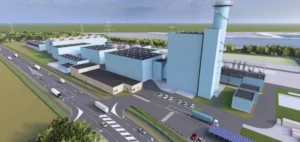Lithuania has informed the European Commission of its measure to support AB Achema’s project to replace fossil hydrogen with renewable, low-carbon hydrogen in fertilizer production. The funding, from the Just Transition Fund, will be provided in the form of a direct grant for the installation of a 171 MW alkaline electrolyser at AB Achema’s production site in the Kaunas region. Currently, the hydrogen used to produce ammonia at AB Achema is based on natural gas. The new electrolyzer will produce renewable, low-carbon hydrogen, reducing hydrogen consumption from natural gas by 30% and cutting CO2 emissions. In parallel with decarbonization, renewable energies are accelerating their development in Lithuania, as illustrated by the joint project between Utilitas Wind and Latvenergo.
Economic impact and project objectives
Scheduled for commissioning in 2026, the project is expected to save Lithuania at least 5.8 million tonnes of CO2 over a 19-year period. AB Achema is committed to sharing the experience and technical knowledge acquired during this project via publications and conferences, in order to contribute to the deployment of clean technologies in the fertilizer industry. This initiative is in line with the objectives of the European Hydrogen Strategy, the European Green Deal and the Green Deal Industrial Plan, while helping to reduce dependence on Russian fossil fuels in line with the REPowerEU plan.
Assessment and regulatory framework
The European Commission has assessed this measure in accordance with EU state aid rules, in particular Article 107(3)(c) of the Treaty on the Functioning of the European Union (TFEU) and the guidelines on state aid for climate, environmental protection and energy (CEEAG). The Commission concluded that this aid facilitates the development of an economic activity, supports key EU objectives and has an incentive effect, as without this public support the investment in the electrolyser would not take place.
The project is deemed necessary and appropriate to promote fertilizer production with a reduced carbon footprint. What’s more, it’s proportionate, as the level of aid corresponds to actual financing needs. Safeguard mechanisms, such as the return of part of the aid in the event of excessive financial success (recovery mechanism), are in place to limit distortions of competition.
Economic and industrial consequences
Decarbonizing fertilizer production is a priority for the European industrial sector, particularly in a context where dependence on fossil fuels is being strongly questioned. The installation of this electrolyzer represents a significant technological advance that could serve as a model for other companies in the sector. The transition to cleaner production processes requires considerable investment, and state support plays a crucial role in initiating these transformations.
AB Achema’s project is not just a technical improvement, but also a strategic change in the way fertilizers are produced. By investing in low-carbon technologies, the company is positioning itself favorably on the European and global markets, responding to the growing demands for sustainability from regulators and consumers alike.
Future prospects and implications
By providing this aid, Lithuania is helping AB Achema to strengthen its renewable and low-carbon hydrogen capacities, thereby contributing to the decarbonization of the fertilizer value chain and to the EU’s goal of climate neutrality by 2050. This project could encourage other companies in the sector to adopt similar technologies, creating a beneficial multiplier effect for the industry as a whole.
In addition, this initiative is likely to improve the competitiveness of the fertilizer industry in Europe, by enabling producers to reduce their long-term costs through the use of renewable energy sources and lower taxes on carbon emissions. Reducing dependence on natural gas imports could also enhance Europe’s energy security.
In short, the European Commission’s support for AB Achema represents an important step towards modernizing and decarbonizing the fertilizer industry, with major economic and industrial implications for Lithuania and the European Union as a whole. The adoption of clean technologies and adequate state support are key to achieving the EU’s ambitious climate and energy objectives.





















